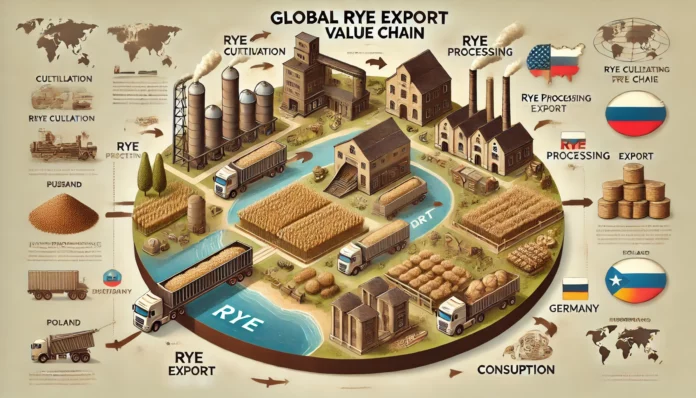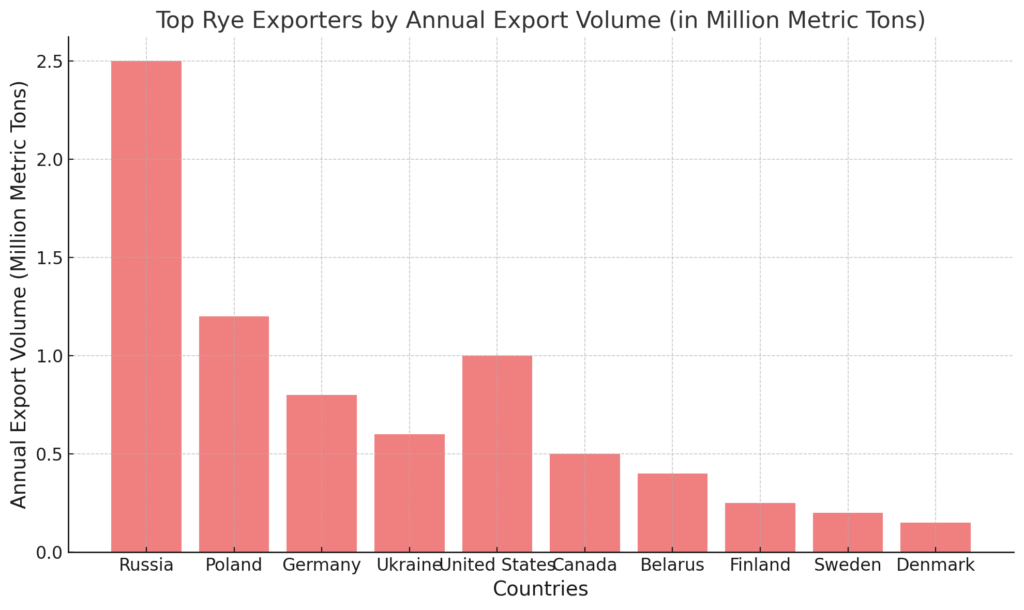
Introduction
Rye is a hardy cereal grain that has been cultivated for thousands of years. Though it is not as widely grown or traded as wheat, it still plays a critical role in global agriculture and food production. Rye is used in a variety of food products such as rye bread, crackers, and other baked goods, as well as in alcoholic beverages like whiskey and vodka. Beyond its domestic consumption, rye is also an important agricultural export for many countries. This report explores the top 10 rye-exporting countries worldwide, highlighting their key export figures, regional importance, and factors contributing to their success in the global rye market.

Top 10 Rye Exporters in the World
Below are the top 10 countries that lead the world in rye exports. These countries are major players in the rye market, contributing significantly to global rye trade. The factors driving their export success include high production levels, favorable agricultural conditions, and strong demand for rye-based products in international markets.
1. Russia
Russia is the largest exporter of rye in the world, accounting for a significant portion of global rye trade. In 2021, Russia exported approximately 2.5 million metric tons of rye, making it the dominant force in the rye export market. Russian rye is primarily exported to neighboring countries in Europe, including Ukraine, Belarus, and Kazakhstan, as well as to parts of Asia and the Middle East.
Russia’s rye production is vast due to its cold climate and large agricultural areas, particularly in Siberia and the European part of the country. The country also benefits from low production costs and government support for agriculture, making it a competitive exporter in the global market.
Russian rye is mainly used for bread-making, animal feed, and the production of vodka, with an increasing focus on organic rye as global demand for sustainable agricultural products grows.
2. Poland
Poland is another leading exporter of rye, with annual rye exports totaling around 1.2 million metric tons. Poland’s position as a top rye producer makes it one of the primary exporters of this grain. The country exports rye to several European countries, including Germany, the Netherlands, and Italy, as well as to countries in Asia and the Middle East.
Poland’s rye exports are driven by the country’s strong domestic rye bread culture, which has made rye an essential crop in the national agricultural system. Polish rye is also used in the production of alcoholic beverages, including vodka, which has further fueled export demand.
Poland’s rye export industry is supported by favorable agricultural policies and a long tradition of rye cultivation, ensuring that the country remains a key player in the global rye market.
3. Germany
Germany is one of the largest exporters of rye in Europe, with an annual export volume of approximately 800,000 metric tons. German rye is exported to various countries, particularly within the European Union, where it is used in the production of rye bread and other baked goods.
Germany is known for its high-quality rye, which is a staple in traditional German bread-making. The country’s rye export industry is strengthened by its advanced agricultural practices and efficient logistics systems, allowing it to meet the demands of both domestic and international markets.
In addition to bread production, Germany’s growing craft beer industry has spurred demand for rye in brewing, contributing to the country’s expanding rye export market.
4. Ukraine
Ukraine is another significant exporter of rye, with an annual export volume of around 600,000 metric tons. Rye production in Ukraine is concentrated in the northern and central regions of the country, where the climate is favorable for rye cultivation. Ukrainian rye is primarily exported to neighboring countries such as Russia and Poland, but it is also sent to the European Union, the Middle East, and parts of Asia.
Rye in Ukraine is used for bread-making and the production of vodka, both of which are essential components of Ukrainian culture. Despite challenges related to political instability and economic conditions, Ukraine remains a key player in the rye export market.
Ukraine’s position as a major exporter is also bolstered by its proximity to the EU, which facilitates trade and reduces transportation costs.
5. United States
The United States is a notable exporter of rye, producing around 1 million metric tons annually. While the U.S. is not a top producer of rye compared to Russia or Poland, its rye export industry has grown significantly due to increasing demand for rye whiskey, a popular American spirit. The U.S. exports rye to countries such as Canada, the United Kingdom, and several other nations in the Americas and Europe.
U.S. rye is used primarily for whiskey production, and the country’s growing craft whiskey market has further driven demand for rye as a key ingredient. In addition to whiskey, rye is also used for baking and animal feed in the U.S.
The U.S. export market is supported by advanced agricultural practices, a well-developed transportation network, and strong demand for rye whiskey both domestically and internationally.
6. Canada
Canada is another key exporter of rye, with annual rye exports reaching approximately 500,000 metric tons. Rye in Canada is mainly grown in the Prairie provinces, where it thrives in the cool climate. Rye in Canada is used for the production of rye whiskey, which is a popular product in the country, as well as for bread and animal feed.
Canada’s rye export market is particularly strong due to its proximity to the United States, one of the largest consumers of rye whiskey. Canadian rye is also exported to other countries in Europe and Asia, driven by global demand for high-quality rye-based products.
Canada’s rye export industry is supported by advanced agricultural technology and favorable trade agreements, which help reduce export costs and boost competitiveness.
7. Belarus
Belarus is a significant exporter of rye, with annual rye exports reaching around 400,000 metric tons. Belarusian rye is mainly exported to neighboring countries such as Russia, Poland, and Ukraine, as well as to other countries in Europe. Belarus’ rye is primarily used for bread-making and animal feed.
Belarus’ rye export industry is supported by the country’s favorable agricultural policies, which encourage the cultivation of rye and other cereal grains. The country’s rye farming practices are increasingly focused on sustainability, with many Belarusian farmers adopting organic farming techniques to meet global demand for sustainable agricultural products.
8. Finland
Finland is a smaller but significant exporter of rye, with annual exports reaching approximately 250,000 metric tons. Rye is a staple in Finnish cuisine, particularly in the form of rye bread, which is an essential part of the national diet. Finnish rye is primarily exported to neighboring countries such as Sweden and Norway, as well as to other European countries.
Finland’s rye export industry is driven by the high quality of Finnish rye and the country’s emphasis on sustainable and organic farming practices. Finland’s rye production benefits from the country’s cool climate, which is ideal for growing rye.
9. Sweden
Sweden is another notable exporter of rye, producing around 200,000 metric tons annually. Swedish rye is primarily exported to neighboring countries in Scandinavia, as well as to other parts of Europe. Rye is used extensively in Sweden for bread-making and is an important part of Swedish food culture.
Sweden’s rye export industry is bolstered by the country’s strong agricultural sector and commitment to sustainable farming practices. Swedish rye is highly regarded for its quality, and the country’s advanced agricultural methods ensure that it remains competitive in the global market.
10. Denmark
Denmark is a smaller exporter of rye, with annual exports totaling around 150,000 metric tons. Rye is grown in Denmark’s cooler northern regions, where it is used primarily for bread-making and animal feed. Danish rye is exported mainly to other European countries, where it is used for food products.
Denmark’s rye export market is supported by the country’s efficient agricultural sector and its emphasis on organic and sustainable farming practices. The Danish government provides support for rye farmers, helping to maintain high production levels and ensure a steady supply of rye for export.
Conclusion
Rye is an essential crop for many countries, and its importance extends beyond domestic consumption to global trade. The top 10 rye exporters, including Russia, Poland, and Germany, are leading players in the global rye market, driven by factors such as favorable growing conditions, strong domestic demand, and efficient agricultural practices. As global demand for rye-based products like bread and spirits continues to grow, these countries are likely to remain key exporters, meeting the needs of consumers around the world.



